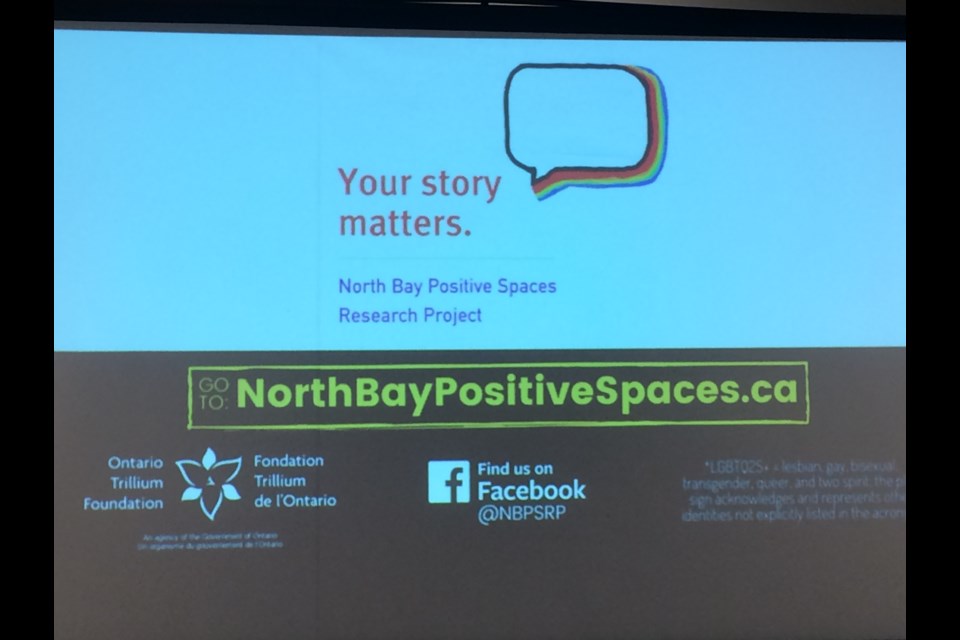The North Bay Positive Spaces Research Project has just released its findings into what the local LGBTQ2S+ community needs to receive “safe, meaningful and inclusive services” in North Bay.
Data was collected over the past year, through an online anonymous survey, confidential focus groups, and one-on-one interviews.
Research coordinator Candace Ghent (pronouns they/them) said respondents gave thought provoking answers.
“For me personally, as someone who is a member of the LGBTQ2S+ community, I was surprised at the need the community recognized for service providers to have training. We know they need training, but it was surprising because folks in the community were generous enough to recognize that there’s opportunities for folks to learn, we just need for those opportunities to be there,” said Ghent.
“So that was not surprising in a traditional sense, but surprising in the insight of the community, and that they’ve clearly spent a lot of time thinking about what we need to do here.”
Meg Ramore, (pronouns she/her) is a member of the research team and North Bay Local Immigration Partnership Coordinator housed at the North Bay Multicultural Centre.
Ramore found an increase over the years, in the number of people going to the centre looking for a safe place, if only for a few minutes.
“What I was hearing despite people coming in and asking for help, and despite individual service providers connecting with me, the broader organizations or boards weren’t recognizing it as a priority. So we needed population data. We had to prove to people that these people are here, and that they have needs,” said Ramore.
“So we asked a series of questions. Where do you feel safe? What makes you feel safe? What do you want? What do you need and all those types of questions. And especially asking about their identity in an intersectional way, that not just are you queer or are you gay, but are you racialized? Do you have a disability? Are you Indigenous? Are you also homeless or low income? Because all of this impacts. And what we were seeing is that our community is so diverse, I would argue that it’s more diverse than bigger centers.”
Ramore said some of the key issues focused on the fact many people don’t feel like they belong, or they aren’t believed, or just how complex the needs are in the community.
“LGBTQ2S+ people don’t have a sense of belonging. They want to belong because connected to belonging is that you don’t feel you belong if you don’t feel safe. You don’t feel like you belong, if no one believes you, that you are the identity that you say you are. Or you don’t see yourself reflected in services or leadership,” said Ramore.
The findings were presented during a public forum that included service providers, business owners, community members and local politicians.
“It’s not just about investing money, but investing time and paying attention to policies and that’s why we have three different recommendations. We have service provider recommendations, we have community calls to action, and future hopes. All of it is formed by the stories of LGBTQ2S+ folk.”
Ramore says the 140 participants invested a lot of time identifying issues they saw as needing change, a bigger response than communities with a much larger population base.
“It took an hour and a half to do the survey. Think about how much time was invested, how much people really wanted to share. Each question we had, most had a tick box and then share more if you want. People kept sharing more. We had hundred’s of pages of data from the survey. Barrie had less than 140 people participate, and they have service centers that are specifically and only for LGBTQ people. Hamilton as well, they have multiple service centers. They have more than a half-million people, and they had in and around 140 participants.”
It is now up to others to run with the findings coming from the report.
“From here what we want, what we’re hoping and the reason why we’re making all the data public, gifting all these recommendations is that we want other folks to take it up. Do stuff for your own services, for your own HR policies, create new programs. We’ll even tell you what grants to apply for,” said Ramore.
“If someone puts the question to me of what’s next? I’d say well you tell me, because with this research its really been laid out the ways that we can make services better, the kinds of services people need, the things that we need to be thinking about in terms of rebuilding that trust and building a connection and relationship between service providers in the community. Hopefully, they feel empowered at least to recognize where do we fit? Are we just starting to commit? Are we investing? Do we need to invest more? The conversation is for everyone to have.”
Ghent says people need to keep the dialogue going.
“From the very beginning of this project, we have recognized that this is part of what will always have to be an on-going conversation. This project has allowed us to capture what folks in the LGBTQ2S+ community need, and now we can deliver that is a safe way without them having to advocate for themselves, and bring that conversation to the level of service providers and local leaders.”
Ramore says the full report will be made available online in early October at northbaypositivespaces.ca



